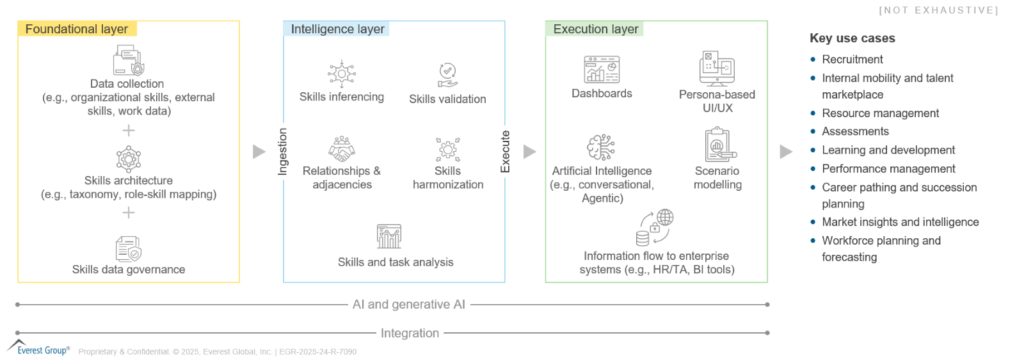
Microsoft recently announced the general availability of People Skills, an artificial intelligence (AI)-driven skills intelligence solution, along with Skills Agent, an AI-powered assistant within the Microsoft 365 Copilot ecosystem.
People Skills uses AI technology (powered by OpenAI models) to infer employee skills based on day-to-day activities within Microsoft 365 applications such as emails, documents, and meetings, generating dynamic skill profiles. Skills Agent uses this data to assist managers in quickly identifying suitable talent, helping employees locate colleagues with relevant skills, and supporting individual skill development.
These tools integrate into Microsoft’s existing productivity and employee experience platforms, notably Microsoft 365 and Viva. They come with an extensive built-in skills taxonomy developed in collaboration with LinkedIn, which includes more than 16,000 customizable skills, as we highlight in our latest blog.
Reach out to discuss this topic in depth.
Problems that People Skills and Skills Agent solve
The recent developments from Microsoft aim to address several persistent challenges in talent management:
- Real-time, automated skills inventory: Traditional employee skills inventories are static, relying heavily on manual updates, leading to out-of-date or incomplete information. People Skills addresses this by automatically capturing skills through continuous AI-based inference, significantly reducing manual effort and ensuring skill data remains current
- Facilitating talent identification: Skills Agent helps managers identify internal talent efficiently by automatically surfacing individuals with relevant skills, potentially reducing the time and effort associated with staffing and project initiation
- Support for employee development: Employees receive insights into their skill sets, with targeted learning suggestions provided through integration with Viva Learning. This approach aims to support personalized development paths, potentially contributing to improved employee engagement and growth
- Leveraging existing technology investments: Organizations already using Microsoft 365 or Viva Suite can integrate these capabilities without additional licensing costs, potentially simplifying their overall talent management technology landscape
What challenges remain
Despite these developments, several challenges remain:
- Limited integration with external HR and business systems: The current offering primarily infers skills from Microsoft 365 data, lacking deep integration with other essential Human Resources (HR), work, and business platforms. This creates a partial view of skills, preventing organizations from having a holistic picture of their workforce capabilities
.
- Incomplete skills and proficiency mapping: People Skills focuses mainly on identifying the presence of skills but does not measure skill proficiency levels effectively. Without proficiency metrics, organizations may struggle to accurately match talent to critical roles, risking suboptimal resource allocation
.
- Validation and accuracy concerns: Skill validation primarily relies on employee self-review and confirmation, raising accuracy concerns. Without structured validation mechanisms, such as manager reviews or formal assessments, the reliability of the inferred skills data could be questionable, potentially undermining trust and usability for high-stakes decision-making
.
- Taxonomy fragmentation and complexity: Introducing yet another skills taxonomy, although customizable, creates complexity in skills management. Enterprises already managing skill taxonomies across multiple platforms may now either need to reconcile and integrate another taxonomy or start using the Microsoft skills taxonomy as a common language of skills across the enterprise technology stack. This can increase administrative overhead and create inconsistencies in talent management practices
.
What does the future hold?
Everest Group defines the enterprise skills intelligence platform as an ecosystem comprised of three interconnected layers, Foundational, Intelligence, and Execution – each supported by integration as well as AI and Generative AI (gen AI) capabilities (see Exhibit 1).
Microsoft’s People Skills and Skills Agent primarily address portions of the Intelligence layer (for example, skills inferencing and relationships and adjacencies) and begin to touch the Execution layer through persona-based Copilot experiences and dashboards. As such, they can be a valuable component of a broader skills-based talent strategy.
Exhibit 1: Everest Group’s definition of an enterprise skills intelligence ecosystem

Microsoft’s introduction of People Skills and Skills Agent advances the capabilities in AI-driven skill management, addressing several organizational challenges related to talent visibility and identification. However, to unlock the full potential of this ecosystem, organizations may still need answers to some of the key questions:
- How will foundational data (taxonomy, role-skill mapping, governance) be curated and maintained?
- What processes will validate proficiency and harmonize skills across disparate systems?
- What dashboards, scenario-modelling tools, and AI agents will lead to actionable workforce decisions?
Organizations considering adopting these tools should evaluate complementary solutions and governance structures to address these potential gaps effectively. By mapping Microsoft’s capabilities to the Everest Group value chain, enterprises can more clearly identify complementary solutions, integration requirements, and governance processes needed to complete the end-to-end skills intelligence picture.
If you found this blog interesting, please check out our recently published PEAK Matrix Assessment on Skills intelligence platforms (LINK).
If you have any further questions regarding the ever-changing landscape of global HR and Talent, please contact Shikhar Agrawal ([email protected]), Sharath Hari ([email protected]) and Varisha Jain ([email protected]).











